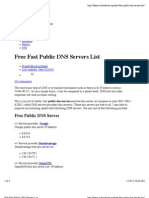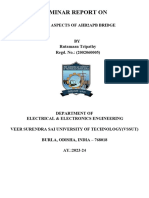Scripting Internal Debugging and Shell CMD For Android
Uploaded by
ankurmishraerScripting Internal Debugging and Shell CMD For Android
Uploaded by
ankurmishraerAndroid Debug Bridge
ADB Command
Scripting commands
Wait for the device to be in the specified state.
state : Values can be device , recovery , sideload , or bootloader .
transport : Values can be usb , local , or any .
adb wait-for [-transport] -state
Print the adb state of a device. The adb state can be print offline , bootloader ,
or device .
adb get-state
Print the adb device serial number string.
adb get-serialno
Print the adb device path.
adb get-devpath
Remount the /system , /vendor , and /oem partitions in read-write mode.
adb remount
Reboot the device. This command defaults to booting the system image, but also
supports bootloader and recovery .
The bootloader option reboots into bootloader.
The recovery option reboots into recovery.
The sideload option reboots into recovery and starts sideload mode.
The sideload-auto-reboot option is the same as sideload , but reboots after
side loading completes.
adb reboot [bootloader | recovery | sideload | sideload-auto-reboot ]
Side load (install in APK format) the specified full OTA package onto the device.
adb sideload otapackage
Restart adbd with root permissions.
adb root
Restart adbd without root permissions.
adb unroot
Restart the adb server listening on USB.
adb usb
Restart the adb server listening on TCP at the specified port.
adb tcpip port-number
Internal debugging commands
Check whether the adb server process is running.
adb start-server
Terminate the adb server process.
adb kill-server
Force a reconnect from the host.
adb reconnect
Force a reconnect from the device to force a reconnect.
adb reconnect device
Shell commands
Start a remote interactive shell in the target device.
adb shell
Issue a shell command in the target device and then exit the remote shell. Use any
combination of the following options:
-e : Specify an escape character or the value none if you do not want to use
an escape character. If you do not provide a value, the default escape character (a
dash ( - )), is used.
-n : Do not read from stdin .
-T : Disable pseudo-terminal utiity (PTY) allocation.
-t : Force PTY allocation.
-x : Disable remote exit codes and stdout/stderr separation.
adb shell -e escape_char [-n] [-T] [-t] [-x] [command]
Run an emulator console command
adb emu command
You might also like
- List of Bloatware Apps Safe To Remove Samsung Galaxy S3 S2100% (1)List of Bloatware Apps Safe To Remove Samsung Galaxy S3 S22 pages
- 5G NR Measurement - Serving Cell and Neighbor CellNo ratings yet5G NR Measurement - Serving Cell and Neighbor Cell3 pages
- Android Debug Bridge - Android DevelopersNo ratings yetAndroid Debug Bridge - Android Developers11 pages
- Accessing Remote Android Mobile ContentsNo ratings yetAccessing Remote Android Mobile Contents6 pages
- How To Install TWRP On Samsung Galaxy Core Prime (Guide) - DottechNo ratings yetHow To Install TWRP On Samsung Galaxy Core Prime (Guide) - Dottech2 pages
- Install Apps To SD Card On Your Android Phone Without Rooting It - Plugged inNo ratings yetInstall Apps To SD Card On Your Android Phone Without Rooting It - Plugged in61 pages
- How To Run Android Emulator On Ubuntu or Debian - Linux FAQNo ratings yetHow To Run Android Emulator On Ubuntu or Debian - Linux FAQ13 pages
- Setup or Reconfigure EW-7438RPn Series N300 WiFi Extender - EDiMAXNo ratings yetSetup or Reconfigure EW-7438RPn Series N300 WiFi Extender - EDiMAX1 page
- Dual Boot Kali With Windows - Kali Linux Official DocumentationNo ratings yetDual Boot Kali With Windows - Kali Linux Official Documentation5 pages
- (PDF) LTE Phone Number Catcher - A Practical Attack Against Mobile Privacy - Semantic ScholarNo ratings yet(PDF) LTE Phone Number Catcher - A Practical Attack Against Mobile Privacy - Semantic Scholar1 page
- (Mobile Education) Unlocking Bootloader & Rooting Your Device! - Z-CommunityNo ratings yet(Mobile Education) Unlocking Bootloader & Rooting Your Device! - Z-Community5 pages
- Inferno Unitool V1.5.7 Crack Setup Free Download: What'S Hot!No ratings yetInferno Unitool V1.5.7 Crack Setup Free Download: What'S Hot!1 page
- A-Z List of Windows CMD Commands - Also Included CMD Commands PDFNo ratings yetA-Z List of Windows CMD Commands - Also Included CMD Commands PDF1 page
- Here's An A-Z of Handy Linux Commands!: Rate This News: (1 Votes)No ratings yetHere's An A-Z of Handy Linux Commands!: Rate This News: (1 Votes)5 pages
- (GUIDE) Rooting The UMIDIGI F2 - Magisk - TW - Android Development and HackingNo ratings yet(GUIDE) Rooting The UMIDIGI F2 - Magisk - TW - Android Development and Hacking7 pages
- Websites Relating To Genetic EngineeringNo ratings yetWebsites Relating To Genetic Engineering5 pages
- (Kali - Training) Managing Users and GroupsNo ratings yet(Kali - Training) Managing Users and Groups6 pages
- How To Install Linux: Installing Any Linux DistributionNo ratings yetHow To Install Linux: Installing Any Linux Distribution3 pages
- Comprehensive Vulnerability Analysis of at Commands Within The Android EcoysystemNo ratings yetComprehensive Vulnerability Analysis of at Commands Within The Android Ecoysystem19 pages
- Forensic Analysis of WhatsApp On Android SmartphonesNo ratings yetForensic Analysis of WhatsApp On Android Smartphones33 pages
- PowerSpy: Location Tracking Using Mobile Device Power AnalysisNo ratings yetPowerSpy: Location Tracking Using Mobile Device Power Analysis13 pages
- Cracking BSNL 3G Data Card To Use Different SIMNo ratings yetCracking BSNL 3G Data Card To Use Different SIM1 page
- What Can You Do With Windows Subsystem For LinuxNo ratings yetWhat Can You Do With Windows Subsystem For Linux14 pages
- How To Tame Your Unicorn: Exploring and Exploiting Zero-Click Remote Interfaces of Huawei SmartphonesNo ratings yetHow To Tame Your Unicorn: Exploring and Exploiting Zero-Click Remote Interfaces of Huawei Smartphones102 pages
- Universal Rooting Methods: Disclaimer: Rooting Your Device Will Void Its Warranty. in Addition, Performing TheNo ratings yetUniversal Rooting Methods: Disclaimer: Rooting Your Device Will Void Its Warranty. in Addition, Performing The5 pages
- Quick Guide for Obtaining Free Remote Desktop Protocol (RDP) ServicesFrom EverandQuick Guide for Obtaining Free Remote Desktop Protocol (RDP) ServicesNo ratings yet
- Android Debug Bridge Commands Cheat Sheet: Full ListNo ratings yetAndroid Debug Bridge Commands Cheat Sheet: Full List6 pages
- BCCH CCCH CTCH DCCH DTCH PCCH BCH CPCH DCH DSCH E-Dch Fach HS-DSCH PCHNo ratings yetBCCH CCCH CTCH DCCH DTCH PCCH BCH CPCH DCH DSCH E-Dch Fach HS-DSCH PCH4 pages
- Codec Data Rate Sampling Rate VAD Supported Packetisation Time (Ptime)No ratings yetCodec Data Rate Sampling Rate VAD Supported Packetisation Time (Ptime)4 pages
- 5G NG Identities (UE and Network Identifiers)No ratings yet5G NG Identities (UE and Network Identifiers)1 page
- Coverage and Capacity Calculations For 3G Mobile Network PlanningNo ratings yetCoverage and Capacity Calculations For 3G Mobile Network Planning5 pages
- File Transfer Commands: Android Debug Bridge ADB CommandNo ratings yetFile Transfer Commands: Android Debug Bridge ADB Command1 page
- LTE Technology and LTE Test A Deskside Chat: April 2009100% (6)LTE Technology and LTE Test A Deskside Chat: April 200992 pages
- Global Options: Android Debug Bridge ADB CommandNo ratings yetGlobal Options: Android Debug Bridge ADB Command2 pages
- HP Storageworks Arrays: Enterprise Midrange Entry LevelNo ratings yetHP Storageworks Arrays: Enterprise Midrange Entry Level30 pages
- Sitronix: 65 X 132 Dot Matrix LCD Controller/DriverNo ratings yetSitronix: 65 X 132 Dot Matrix LCD Controller/Driver49 pages
- Unit-2 Embedded C Coding Example - cs3691No ratings yetUnit-2 Embedded C Coding Example - cs369127 pages
- Gpuview Overview: Getting Started With Gpuview100% (1)Gpuview Overview: Getting Started With Gpuview31 pages
- LCFC Confidential: NM-A221 Rev1.0 SchematicNo ratings yetLCFC Confidential: NM-A221 Rev1.0 Schematic81 pages
- Front Interface Module: Specifications & ConfiguratorNo ratings yetFront Interface Module: Specifications & Configurator2 pages
- END USER - Wave4 - OutsmartWithProLiant - PromoNo ratings yetEND USER - Wave4 - OutsmartWithProLiant - Promo8 pages
- Predictive Power Consumption Model For Compute Intensive Applications in Clustered ARM A53 Embedded SystemsNo ratings yetPredictive Power Consumption Model For Compute Intensive Applications in Clustered ARM A53 Embedded Systems4 pages
- CAT Operation Manual Rev. A Created On 2008/09/10No ratings yetCAT Operation Manual Rev. A Created On 2008/09/1027 pages











































































































